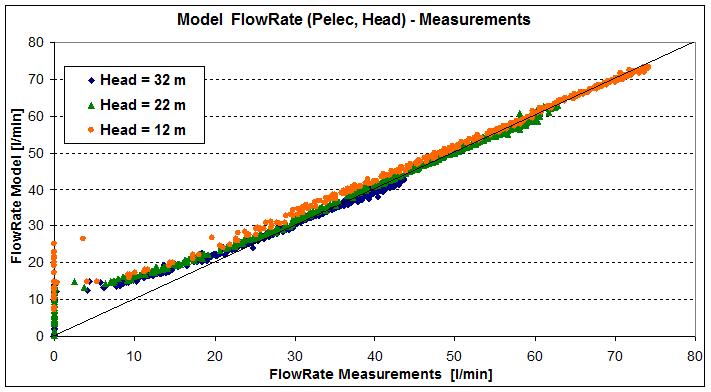|
<< Click to Display Table of Contents >> Pump model from Head (and P) as f(FR), fixed U or speed |
  
|
|
<< Click to Display Table of Contents >> Pump model from Head (and P) as f(FR), fixed U or speed |
  
|
Standard centrifugal pumps designed for grid applications are usually specified by one Head vs Flowrate curve, for nominal grid conditions (fixed voltage, 50 or 60 Hz). To be fully determined, the model will also need the specification of the electrical power (or efficiency) for each given Flowrate(Head) operating point.
This is not always provided by the manufacturers, as the power consumption is not a key parameter when using grid-powered pumps. Pumps without this minimum specifications cannot be used in PVsyst.
Using this only information at nominal speed, centrifugal pump behaviour at other speeds may be very well described by the so-called "Similarity laws" model [see Abella, 2003, Suehrcke, 1997]. These relations state that for two operating points at different speeds along an iso-efficiency line, one has:
FL1/FL0 = ω1/ω0
P1/P0 = (ω1/ω0)²
H1/H0 = (ω1/ω0)³
Using in addition a cubic-spline interpolation on the given Head(FlowRate) curve, solving these equations allows to determine any operating point from two given variables.
Validation
The results are impressive: The next figure shows a comparison between measured and modelled values, for the model established only on 3 operating points at nominal voltage, and for a wide range of operating conditions.

Model validation on a Solarjack SCS-160 pump, CIEMAT Measurements [Abella, 2004]
A significant deviation is observed only at lower flowrates (powers). This is probably due to the converter and motor efficiency change with power (or speed), which are not taken into account here.
Such pumps are most of the time driven by AC synchronous motors, and may be powered using a cheap standard Frequency Converter (FC) [see Abella, 2003]. When using a DC motor, the Ip / Vp characteristics is strongly dependent on the motor technology, and seldom known.